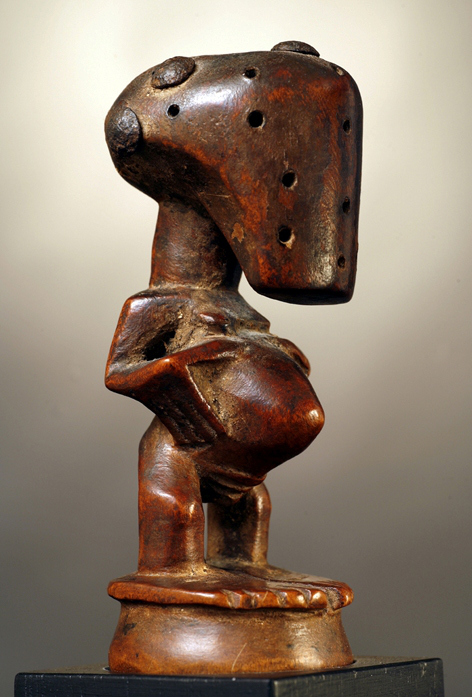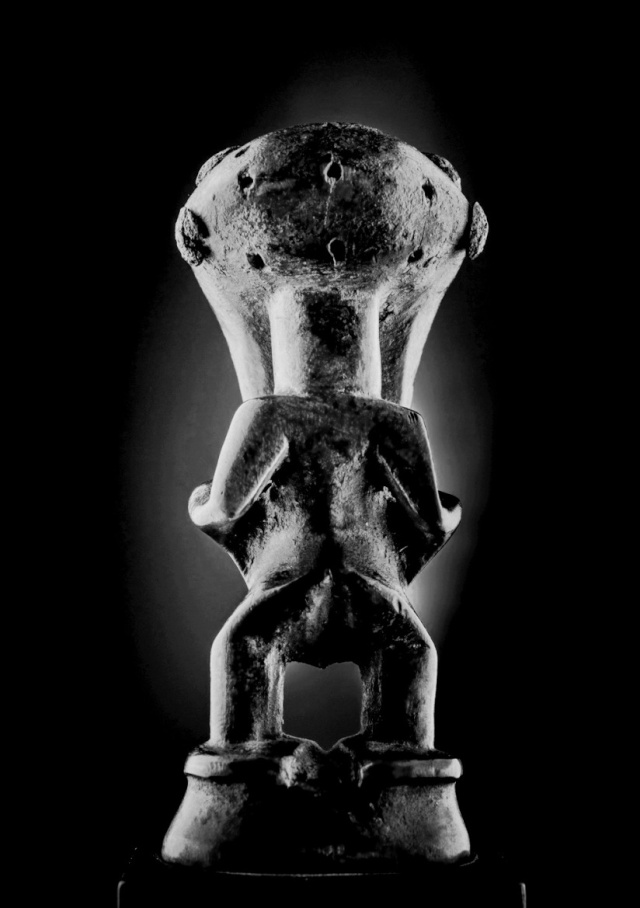Songye people, N’kisi figure, Province du Lomami nord/ouest, Eki, Sanga ou Kalebwe
Pagina 1 di 1
 Songye people, N’kisi figure, Province du Lomami nord/ouest, Eki, Sanga ou Kalebwe
Songye people, N’kisi figure, Province du Lomami nord/ouest, Eki, Sanga ou Kalebwe

Songye people, N’kisi figure, Province du Lomami nord/ouest, Eki, Sanga ou Kalebwe
Bois, métal
H. 4,3 in./cm. 10,8
Provenance:
Ex coll. J.W. Mestach – Bruxelles
Ex coll. Dalton-Somaré – Milano
Exhibition:
Sculture Africane in collezioni private italiane, Gall. Dalton-Somaré, Milano, 2004
L’Africa delle Meraviglie. Arti Africane nelle collezioni italiane. Musée Palazzo Ducale, Genova, 31 décembre 2010 – 5 juin 2011.
Published:
-Vittorio Carini, A Hidden Heritage – Sculture africane in collezioni private italiane, Milano, 2004, fig. 241, color
-Revue “Qui Brescia”, anno 1, n. 2, settembre 2004, Brescia, pag. 149, color
-Private correspondence Willy Mestach/ Elio Revera, Bruxelles.
-Bargna I, e Parodi da Passano G., L’Africa delle meraviglie – Arti africane nelle collezioni italiane, Genova, 2010, Silvana Editoriale, Cinisello Balsamo (MI), pag. 115, color
-Elio Revera, Negli occhi di un altro: lo sguardo “nero”, in Archeologia Africana-Saggi Occasionali, Anno 2012-2013, n.18-19, Milano, 2014, pag.54
Yale University Art Gallery N. 0058927-01

Le territoire Songye
“Dans la zone septetrionale du pays songye, d’ouest en est, du sud au nord, les sculptures se distinguent par la moltiplication des clous à la tête ronde.
Cette pratique semble s’être développée surtout dans le nord-ouest de la province du Lomami.


Courtesy F. Neyt “Songye”.
La présence des clous en lation sur le visage a donné lieu à diverses interprétations. Ces points pourraient se référer aux épidémie diverses que von Wissmann avait déjà constatées lors de son second voyage chez les Songye..
Enfin, ceux –ci peuvent avoir une signification protectrice liée à la foudre et à l’éclair.” (F. Neyt, 2004, pagg. 323, 324)

The Songye peoples have made numerous propitiatory objects against the smallpox.
The Songye territory, in fact, was devastated by this epidemic in the late ‘800 and early’ 900 and of course the tragedy also affected the neighboring population.
As remember Cyrille van Overbergh in his work Les Basonge, 1908, the Songye despite being one of the healthiest peoples of Congo, they were affected by the epidemic, although the number of deaths among these people was lower than that recorded between neighboring ethnic groups. (http://artidellemaninere.com/2014/10/28/contra-variola/)
How has this influenced the creation of many protection fetishes it is difficult to imagine it: the fact is that it is among the Songye which are found numerous minkisi realized for protection of smallpox.

Coll. Corlay
Il popolo Songye ha realizzato numerosi oggetti propiziatori per combattere la malattia del vaiolo.
Le terre Songye infatti furono devastate da questa epidemia tra la fine dell’800 ed i primi del ‘900 e naturalmente la tragedia interessò anche le popolazioni limitrofe.
Come ci ricorda Cyrille van Overbergh nel suo lavoro Les Basonge del 1908, i Songye pur essendo uno dei popoli più sani del Congo, furono interessati dall’epidemia, sebbene il numero dei decessi tra questa gente fu inferiore a quello registrato tra le etnie viciniori.
Come poi abbia influito sul diffondersi della malattia la realizzazione dei numerosi feticci di protezione è difficile immaginarlo: fatto sta, in ogni caso, che è comunque proprio tra i Songye che si riscontrano numerosi minkisi di siffatta tipologia utilizzati, molto probabilmente, contro l’epidemia del vaiolo.
Bibliography
-Van Overbergh, C. “Les Basonge”, Bruxelles, 1908
-Merriam A.P. “Culture History of the Basongye”, Bloomington, 1974
-Mestach J.W. “Etudes Songye. Formes et symbolique, essai d’analyse”, Munich, 1985
-Anthoine C.H.R. “Le système magico-religeux des Songye”, Bruxelles, 1988
-Neyt F. “La Redoutable Statuaire Songye d’Afrique Centrale”, Fonds Mercator, Anvers – 5 Continents, Milano, 2004
-Petridis C. “Art and Power in the Central African Savanna: Luba. Songye. Luluwa. Chokwe”, Mercator Fonds, Bruxelles, 2008
-Volper J. “Autour des Songye. Under the influence of the Songye”, Fine Art Studio Publishing-Gourcuff Gradenigo,2012

 Argomenti simili
Argomenti simili» Songye people, N'kisi figure, Region of Eki or Beneki, Congo
» Dan Gio people, Female Figure, "Lü Mæ", Liberia/Guinea
» Agni people, Maternity Figure, Ivory Coast
» Vili people, Nkisi Figure, Lower Congo Region
» Fon people, Bo-Bocio male, Figure of strength Vodu, Benin
» Dan Gio people, Female Figure, "Lü Mæ", Liberia/Guinea
» Agni people, Maternity Figure, Ivory Coast
» Vili people, Nkisi Figure, Lower Congo Region
» Fon people, Bo-Bocio male, Figure of strength Vodu, Benin
Pagina 1 di 1
Permessi in questa sezione del forum:
Non puoi rispondere agli argomenti in questo forum.|
|
|

 Indice
Indice